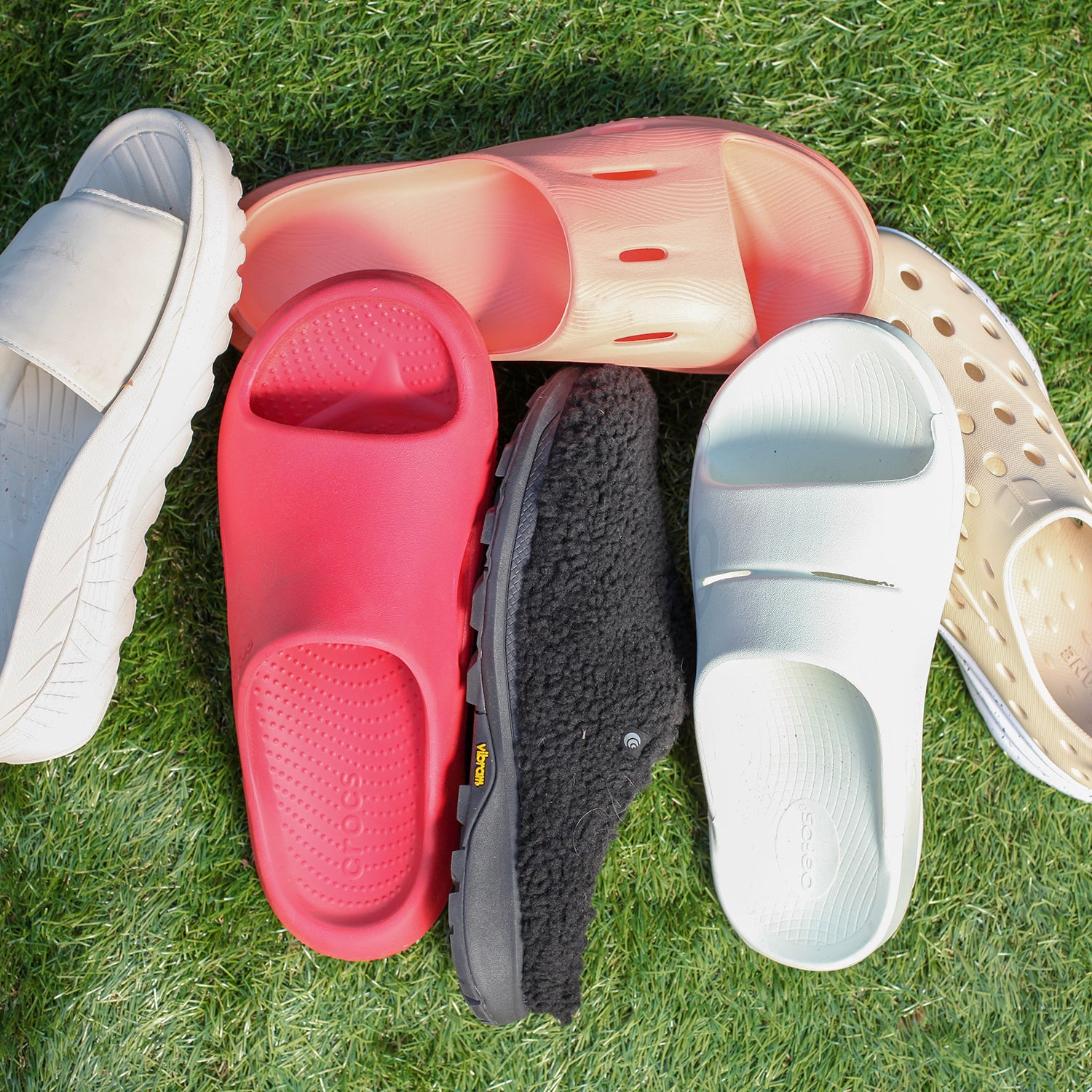Like many multisport athletes, I usually experience the changing of one season to another with equal parts excitement for the new crop of sports—and equal parts full-body soreness. My legs get hammered in the transition from summer to fall as I move from my sitting sports (i.e., rafting, kayaking, and lifestyling in campsites) to hard-charging uphill sports (i.e., mountain biking and trail running). This year is no exception: I spent the last three weeks starting a training block for the Lithia Loop trail marathon in my home town of Ashland, OR, and all my muscles and joints are feeling it. I figured it was the perfect time to test-drive some of the more popular recovery sandals on the market.
Active recovery footwear is most certainly having a moment. It’s technically a category as old as the bedroom slipper—and has existed as a more purpose-made product for more than a decade. But we seem to be reaching a new peak in active recovery footwear. There are new kicks coming out each season and new recovery technologies debuting every year. Recovery research is increasingly showing us all that we cannot ignore this intrinsic part of the training process. I also need more recovery in my life. And, like many of you, I have grown tired of torturing myself with my lacrosse ball.
This truly luxurious trial let me give my barking dogs, tight hips, and sore calves a break (and potentially a recovery boost). And, as a bonus, I get to help you figure out the best recovery sandals for you. Here’s what I found.
If you buy through our links, we may earn an affiliate commission. This supports our mission to get more people active and outside. Learn more.
How I Tested
I started the test with a deep dive deep into recovery sandal research. I scoured reviews until I’d zeroed in on the best recovery sandals on the market, then pulled back the curtain a bit on the science of each one to make sure they weren’t making any bullshit claims. Once I’d called in samples, I subjected each one to a couple of tests.
For starters, I ran a similar 4.5-mile loop 12 times over the course of two weeks and wore each of these sandals for a full day after each run, taking notes on how they felt. I kept the run as uniform as possible and kept my use of the sandals as similar as possible to reduce the number of variables affecting my results. I wore them inside my house, hung out with my kiddo, and took them on the four 0.4-mile head-clearing neighborhood walks I take each day.
In addition to the above daily-driver test, I wore each sandal for an hour and took them each on a 0.4-mile neighborhood walk when my legs were beat to a pulp after my first ambitious 8-mile run. I also cycled through all these sandals after days of manual labor to test their effectiveness against general full-body soreness.
The Results
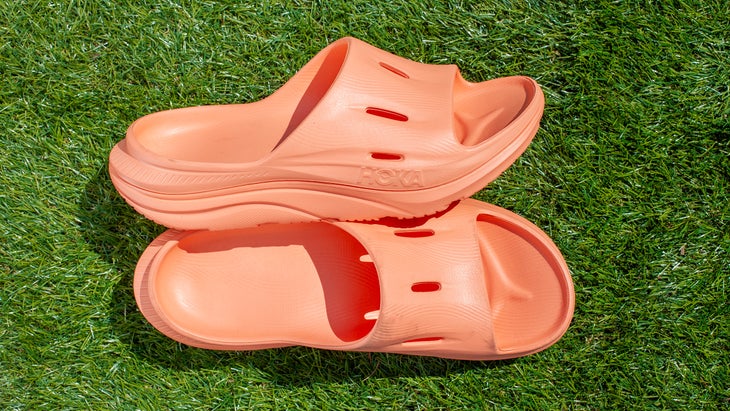
Best for Active Recovery
Hoka Ora Recovery Slide 3
The Ora Recovery Slide 3s were cushy as hell—just as you might expect from the brand that made us fall in love with maximalist shoes. The dual-density foam layup is made from a soothingly soft, sugarcane-based EVA midsole and a sturdier, more supportive EVA outsole. The shoe felt truly therapeutic during my sorest steps around the neighborhood. But it was actually the way these slides helped inform my steps that made me fall in love with them.
The Oras take advantage of their huge 33mm/27mm stack height to carve a serious rockered curve in the front. That helps roll your foot forward with every step. This mechanical aid felt like a hand from an old friend when my legs were achy and tired after a long run. I was able to walk it out further, giving the lactic acid more time to flush out of my system. Wearing these did make my legs feel better over the course of the day. It is worth noting that this rocker profile isn’t for everyone. I bought a pair of these for my dad, and he couldn’t stand the way they messed with his gait—and went back to his beat-to-hell Rainbow Sandals instead.
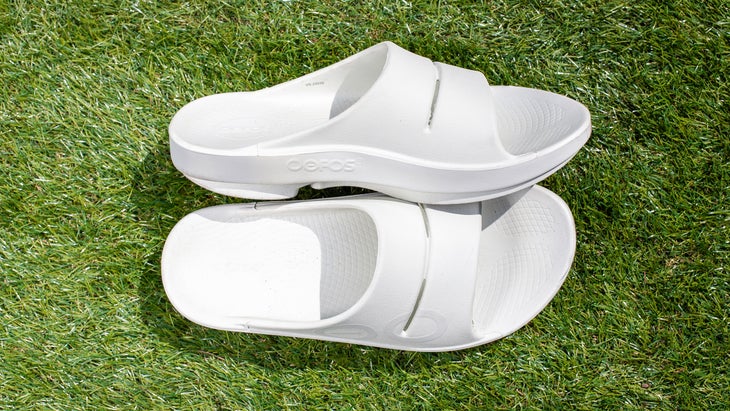
Best for Foot Injuries
OOFOS OOahh Sport Slides
While these slides were not as cushy as the Hokas or Crocs, they did deliver a top-three performance in terms of comfortable walking stride—even on the very first step. That’s thanks to the ample footbed. At first glance, the footbed looks almost comically large, but that extra material allows it to slope inward, creating a three-dimensional hammock for my feet. It delivered support and an extremely stable walking platform, but with an overall width that really gave my feet room to splay out on each step. This unrestricted feeling was appreciated on every walk, but particularly when my feet were swollen after my long run.
The OOah’s were the only recovery sandal I wanted to put on after I sustained an embarrassing toe-overuse injury from not clipping my toenails before a high-mileage week. The downside of that ample footbed and upper is that they felt sloppy during quick movements and were ankle-rolling machines when I was on the playground chasing my six-year-old.
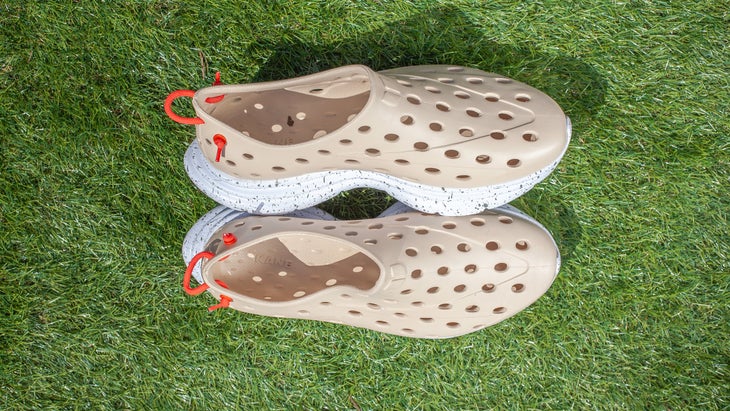
Most Versatile
Kane Revive Active Recovery Shoe
It feels almost embarrassing to call anything “minimalist” in this test, due to how straight-up huge the three slip-on models are. With the Kanes, there’s also an added 10mm heel-to-toe drop—as opposed to the zero-drop Crocs and the 5mm drop on the Hokas. With that said, in terms of movement alone, there was something brilliantly minimalist about how these recovery kicks walked. Credit the heavy longitudinal channels on the outsole, which allowed the shoe to bend laterally with my foot during each step. That flexibility also provided a light stretch to my stiff arches when I walked. I also appreciated the light rocker in the sole, which helped move my steps along.
The Kane Revive is more of a shoe than a sandal, but it still breathed extremely well thanks to the myriad holes in the upper. But the thing I loved most about the show was its versatility. While the footbed texture and smooth ride made them feel like a recovery shoe, plentiful heel support and a more streamlined silhouette made them my favorite for running errands and pretending to be the Loch Ness Monster at my kid’s playground without worrying about rolling my ankle. The biggest con: The fully encased uppers were the toughest to get on and off of the bunch. If I were recovering from an ultra or a multiday objective, I definitely would prefer the ease of a slip-on.
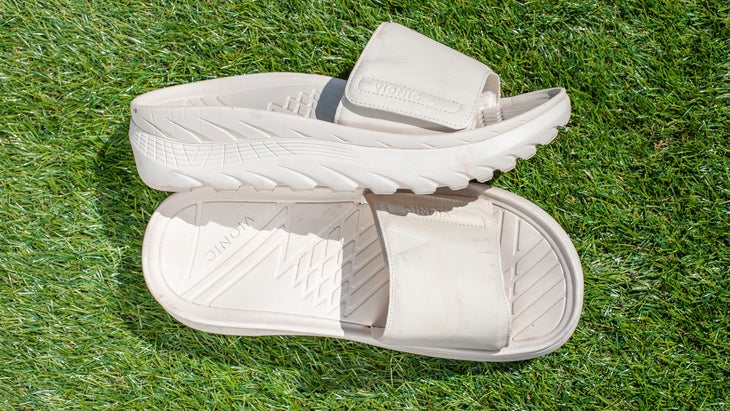
Best Upper
Vionic Rejuvenate Recovery Sandal
The cushioned, two-part upper—which is adjustable via a Velcro strap—really set the Vionics apart from the rest of the sandals in this test. The customizable fit made my entire foot—not just the soles—feel cradled and loved, and the soft brushed cotton-like fabric interior also had a much more organic next-to-skin feel than the plastic uppers of the other slips. While every foot is different, I found its high arches took some getting used to.
For the first 150 to 200 steps, I felt like I was lurching forward, but once I adjusted, I did appreciate the light massage the hump gave the arch of my foot. Another perk is that these slips look much lest orthotic than some of the other options, thanks to that leather-looking adjustable upper. Wearing them made me feel more like a put together adult (when worn with jeans) than a middling-sporty dad when picking up my daughter from school.
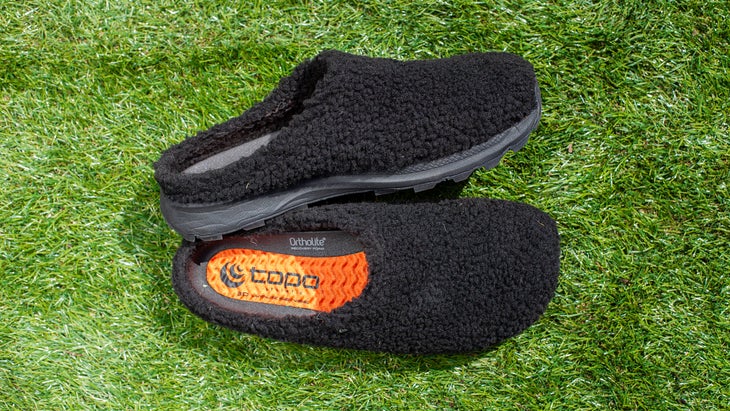
Best Stimulation
Topo Athletic Revive
The pronounced, wavy ridges covering the footbeds of Topo Athletic’s Revives are designed to stimulate blood flow—which is why I turned to them when my feet were at their most swollen. The washboard-like texture provides a light massage with every step, which felt especially good on day three of my training plan when my soles were throbbing. Walking around in these babies seemed to positively affect the swelling.
The Athletic Revives feature a wide toe box, which also allowed my angry toes to splay out and relax. One downside: These lean more towards slippers than sandals with their rugged Vibram outsole and fuzzy upper, so I’m less likely to turn to them as a camp shoe. But in a hut setting? Now we’re talking; I’m already salivating about how they will feel after a long ski tour this winter.
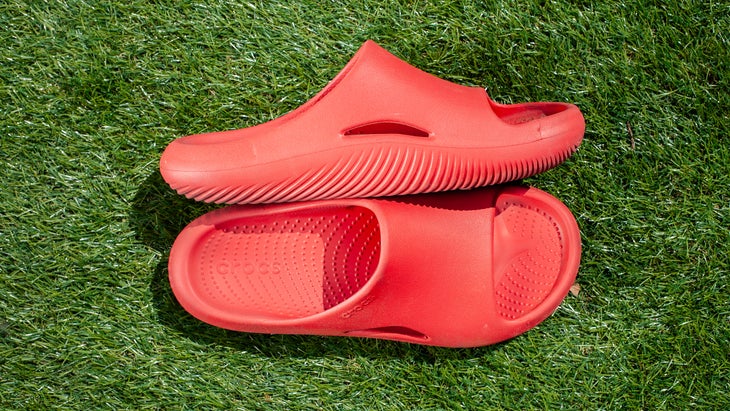
Best Cushion
Crocs Mellow Recovery Slides
��
The steps I have taken in these Crocs have been the softest, most marshmallow-y, and best cushioned of my life. The difference was so noticeable that I made audible pleasure sounds during my first test drive—delivering “oohs” and “aaahs” not yet out of my house. My feet visibly sunk into the footbeds like a fancy memory foam mattress when I first put them on, and they delivered Cadillac-smooth rebound with every single step. These slip-ons were the most luxurious of the bunch in terms of cushioning—and I could feel myself sinking into the cush with each step. That helped my whole leg relax, which translated into a tangible feeling of relief all the way up to my back.
They were my favorites when my legs were their most sore, both after long runs and after manual labor. As for downsides: The Mellows had the least breathable upper in the test, with only two small vents at the base and an ample amount of plastic over the top of my foot. As a result, my feet swamped out pretty badly on hot days.
What Are Recovery Sandals?
Recovery sandals are shoes that are easy to get on and off, are extremely comfortable to walk around in, and stimulate blood flow to your feet. All of the recovery footwear I tested, and most in this category, have versions of the following attributes to achieve those goals:
- Some type of raised surface in the footbed that stimulates blood flow at the bottoms of your feet.
- Cushy feel under foot
- A stable platform to walk on — usually from a wide exterior outsole
- A large, roomy, footbed.
Do I Need Recovery Sandals?
While each purchase has a nuanced answer based on individuals’ needs and budget, my short answer is: yes. If you have the money and don’t mind occasionally getting called out for wearing one of these pretty ostentatious styles in public, they are a great investment. If you are going to wear sandals anyway, why not wear a pair that at best benefits your athletic recovery with every dang step?


